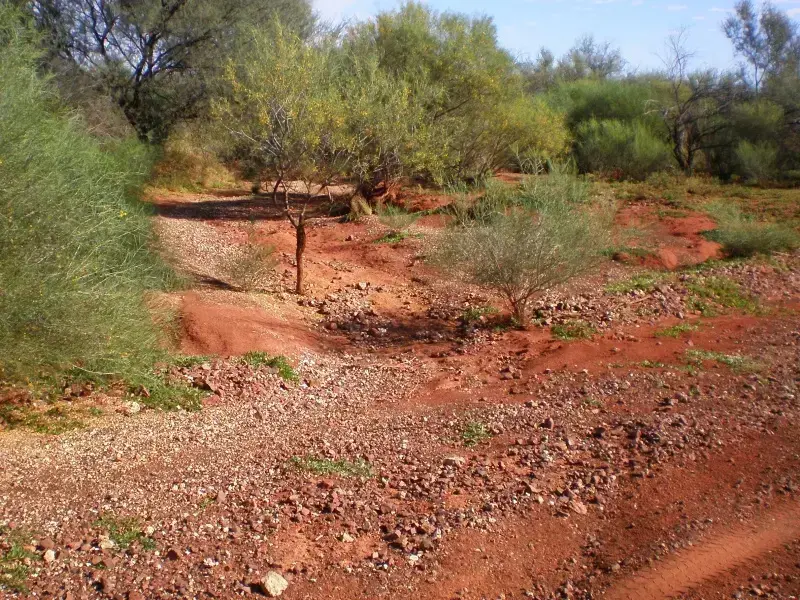‘Three Rivers Station‘
A REGENERATIVE AGRICULTURE CASE STUDY
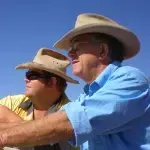
Graham Forsyth and his son Ben have an absolute commitment to the work they are performing on Three Rivers Station to slow the flow of water, restore soil health and regenerate their part of the degraded West Australian rangelands in the Gascoyne River catchment.
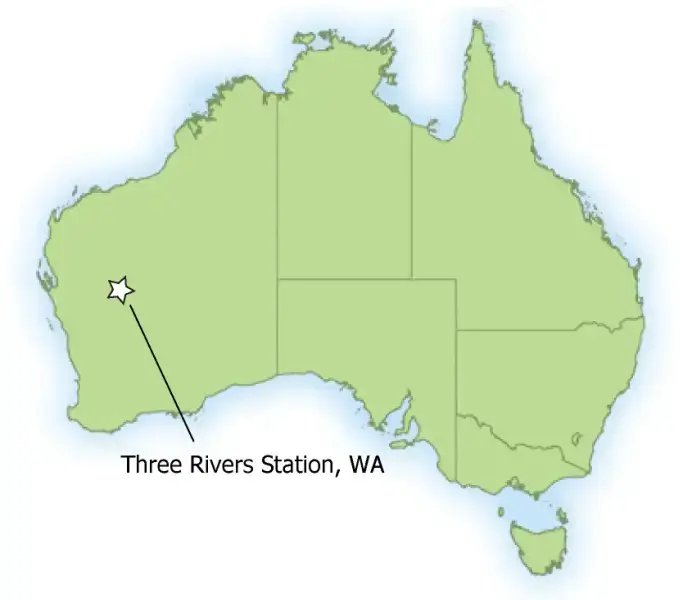
230 km north of Meekatharra, 1000 km north east of Perth, WA Mid West
FARM FACTS
ENTERPRISE: Cattle. Bos Taurus beef production
PROPERTY SIZE: 480,000 hectares
AVERAGE ANNUAL RAINFALL: 225 mm
ELEVATION: 550-600m
MOTIVATION FOR CHANGE: Degraded landscape unable to support stock
INNOVATIONS
- De-stocking of property to allow for regeneration
- Construction of strategic earthworks to slow surface water flow, restore water flow to wetlands and floodplains, reduce erosion, build soil and promote perennial pasture regeneration
- Innovations commenced: 2004
KEY RESULTS
- Gradual regeneration of perennial pastures
- Erosion stabilisation and reduction
- Water ponding and reduced evaporation
Introduction
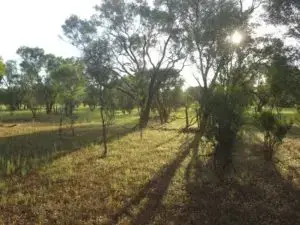
Three Rivers scenery
From their initial purchase of the pastoral lease in 1984, the Forsyth family built Three Rivers Station into a highly successful and extensive beef enterprise. During this time, the family came to realise that traditional management of the rangelands had caused them to decline to a critically fragile level. In response to this knowledge they began to implement different management practices to regenerate rangeland function.
Since 1992, increasing mining operations and exploration on the station has interrupted pastoral operations and made large demands on water supplies in the aquifers. However, it was observing cattle of below expected condition at the 2003 muster that led the Forsyths to make the difficult decision to de-stock their property. This has culminated in the effective suspension of pastoral operations while mine exploration and development is taking place, but has enabled conditions to help restore the landscape.
The Forsyths have turned what could have been a family catastrophe into an opportunity, working with the mining companies to halt the decline and accelerate the regeneration of the rangelands. After building their knowledge on local landscape and function, they have been experimenting with earthworking techniques such as rakes and bunds to stabilise erosion areas and nurturing perennial grass seed banks. This work has seen active gullies stabilised, surface water flow slowed and spread across the landscape and a dramatic increase in the abundance, diversity and vigour of perennial grasses.
Together, Graham and Ben Forsyth are investing in the future to re-establish grazing operations. They are restoring the degraded landscape in their part of the West Australian rangelands.
Background
THREE RIVERS STATION
Three Rivers Station is located at the headwaters of the Gascoyne River in the rangelands in the mid-north of Western Australia, intersected by the Great Northern Highway. It has been used for extensive pastoral operations since 1898. The long term average rainfall is about 225mm with very large variability and a trend towards summer dominant rainfall or significant storm events evident in the last decades.
“We are responsible to produce food that makes people healthy and that gives a fair share to everyone in the supply chain so they can look after their people and the land.”
The Forsyth family purchased the Three Rivers pastoral lease in 1984. In 1992 they sold the lease to Plutonic Gold Mine, which is currently owned by Barrick Resources Pty Ltd of Canada. The Forsyths subsequently sub-leased back the grazing rights to the property.
The Forsyths built up a high quality breeding herd based on Bos Taurus genetics. From 1995 to 2004 the progeny from Three Rivers was used to produce the Forsyth family’s own Three Rivers Beef, which was marketed across Australia, Hong Kong and Japan. The Three Rivers brand was notable not only for the quality of the product, but also for the values the brand embodied: integrity of relationship with the pastoral ecology and ensuring that everyone in the supply chain got a fair share of the profits. As Graham says, “We are responsible to produce food that makes people healthy and that gives a fair share to everyone in the supply chain so they can look after their people and the land”.
The Forsyth family were conservative in their stocking levels and traditionally managed to a carrying capacity of 2,857 large stock units (unit of measure based on the feed requirements for a 450kg steer). Availability of stock water is important when managing grazing in the vast rangelands where the size of the area makes fencing cost-prohibitive. Watering points are used to encourage cattle to move to areas ready to be grazed and to leave areas needing rest. Provision of water for cattle
on Three Rivers Station is from permanent natural water as well as localised watering points. Watering points are supplied from local bores using a combination of windmill, tank and trough as well as solar and diesel pumps.
Initially, processing of ore at Plutonic Mine placed a large demand on water supply. In response, watering points had to be deepened by over a metre to reach the water table. Plutonic have since implemented recycling, water use efficiency programs and tapped into a second water table, somewhat easing the pressure on station water.
THE FRAGILE RANGELANDS
“Generally, soil health in Western Australia’s arid rangelands is historically unknown, or not considered, by land managers.”
Western Australia’s rangelands are vast areas of lands from the headwaters and catchments of major rivers including the Gascoyne and the Murchison. The original sandy loam topsoils have traditionally been a rich resource for extensive grazing operations and have been the base of major industries producing beef, sheep and wool. The rangelands are a fragile and sparsely populated landscape on ancient geology in a harsh and unforgiving climate.
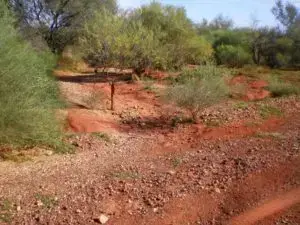
An example of road construction re-directing the flow of water, potentially causing an erosion threat to the floodplain.
The rangelands are also a mineral resource asset. Since starting slowly in the 1960s, mining interest in the area has accelerated. There are currently 40 mining and exploration leases and two active mines on Three Rivers Station. The main mineral interests are copper, gold and iron ore. Mining exploration and operations can be highly disruptive to pastoral enterprises and the landscape as they set up rigs, mines and roads and compete for water from the local aquifers.
There is ample evidence that unfortunately, until recently, some members of the rangeland community have not understood the brittle nature of the land, its vulnerability to the placement and construction of roads, the importance of perennial grasses to the landscape function and the vulnerability of the grasses to over-grazing.
Ben points out, “Generally, soil health in Western Australia’s arid rangelands is historically unknown, or not considered, by land managers. The most limiting soil factor is water and the main symptom of soil ill health is landscape desiccation as a result of loss of perennial ground cover species and nicks in the landscape resulting in an accelerating incising of the drainage lines”.
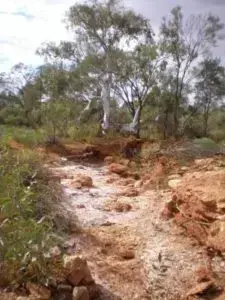
Evident salinity in a streambed.
The land is so brittle that areas of wagon tracks of the old settlers, or accidental ‘nicks’ in the landscape caused by new roads in contemporary times can have a major effect if they result in concentration of water into a channel on bare ground. The landscape is so flat, that an incision measuring only centimetres can change the water course. In large rain events, small incisions can result in rapid gully formation and change the drainages so significantly that the course of the river can be altered, leaving important wetlands and floodplains perched above even the most significant floods. Such a minor incision in this flat landscape can concentrate large amounts of water that should spread gently over the plains without damaging them, into destructive torrents that can wash metres of soil (and salt) downstream. This in turn threatens the productivity of lower areas in the catchment.
As a result of decades of poor grazing practice, the rangeland perennial grasses have steadily declined. This, plus erosion-causing surface damage, has left the fragile topsoil exposed and vulnerable to the variable climate and occasional, but quite extreme rain events. By the latter part of last century, much of the topsoil in the rangelands had eroded, leaving the hard, water-shedding subsoil that can only support sparse annual grasses and shrubs that are tough enough to establish roots.
Changing Practices
A CHANGE IN TRADITION
The Forsyth family was endeavouring to stop erosion and to restore the landscape function whilst running a fully operational pastoral business, however incremental change was not sufficient. Ben points out, “When dramatic change is needed, more often than not dramatic action will be required to jar things out of the current paradigm”.
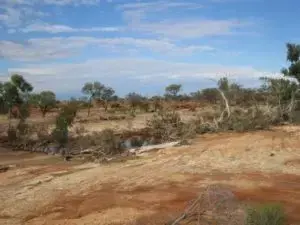
Hard subsoils exposed after loss of topsoil along the river.
Dramatic action was triggered at the 2003 muster when the family observed that the cattle did not look as good as they thought they ought to, given the amount of feed that appeared to be on offer. They made the decision to remove all the mustered cattle from Three Rivers and to de-stock the property. To this day Graham Forsyth is convinced that if he had not done this, many of the cattle would have died the following summer, even if heavy weaning was carried out. This courageous act has cost the family approximately one million dollars in direct costs and lost opportunity from the pastoral lease.
As a consequence, the combination of declined landscape function and the difficulties of integrating their pastoral operations with further mining exploration and expansion prevented the Forsyths from running a viable pastoral business at Three Rivers Station. In Graham’s words, “When your cash flow stops, all hell breaks loose”.
Pastoralists whose stations are already showing signs of degradation and who are also being significantly impacted by mining would be forgiven for selling their lease to the mines and leaving. Instead, the Forsyth family chose to turn what could have been a tragic end to a pastoral family tradition into an opportunity to accelerate rangeland regeneration.
Together, Graham and his son Ben, are forging a new era of pastoral cooperation with mining in the rangelands. They have formed a new business, Three Rivers Contracting, to provide services to the mining companies in support of their exploration and mining operations. This business leverages the Forsyth knowledge of the land, their skills with machinery and earthworks and their business acumen. The machinery used in support of mining is compatible with that needed on the rangeland for regeneration works. It allows them to earn an income from an alternate use of the land and the developing partnership has already enabled strategically important interventions to regenerate this valuable landscape.
Mining companies are obligated to restore the landscapes they have operated in. In the past, many mining restoration works have been focused at the closure of part of a mine, or at the end of operations, levelling hills of overburden into the excavations and restoring vegetation. Generally, the more remote the mine, the less effort devoted to rehabilitation. At Three Rivers, Graham and Ben and their partners in the mines, in particular Barrick Gold, are demonstrating that a great deal of highly effective landscape regeneration can be occurring whilst the mine is still operating. Such a progressive approach to regeneration potentially offers benefits to the mine and its personnel through local service provision to complement the mining company’s own skills, greater landscape amenity through regenerated rangelands and possibly improved security of water supply by greater recharge of the aquifers – as well as beginning the landscape repair required as part of the mine’s exit strategy.
LEARNING IN ORDER TO HEAL
They are now demonstrating that… these pastures can also build soil, guard against erosion and increase ecological complexity and function.
A combination of influences and their own observations led the Forsyth family to recognise that the ecological health of Three Rivers Station was declining and that this was partly due to their own and others’ mismanagement of aspects such as groundwater and roads which could have a negative impact the landscape.
Particularly influential were insights gained from working with respected rangeland ecologists, Dr. Ken Tinley and Dr Hugh Pringle. Together they worked on a program to facilitate ecologically sustainable rangeland management using the Ecosystem Management Understanding (EMU) approach, as delivered jointly by the West Australian Department of Agriculture and the Department of Environment and Conservation. Building on local knowledge, the EMU approach involves reading and recognising the terrain elements in the landscape, their internal and linking functions, condition and trends. This allows for a comprehensive understanding of what the landscape can and cannot offer.
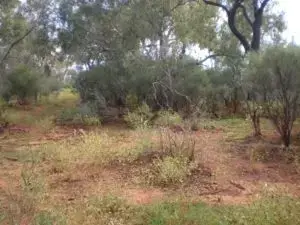
Typical shrub land of sparse grasses and woody weeds.
In addition to participation in these formal programs, the Forsyth family invested a great deal of personal effort in their study of the history, geography and climate of the area to better understand what was happening in the landscape. They used the diaries of the original settlers, examined the notes regarding rainfall and stocking levels from the pastoral families that had previously managed Three Rivers and searched newspaper archives.
They noticed that records from Three Rivers Station showed a repetition of cycles of drought years followed by wet years followed by dramatic reduction in stocking levels. They coupled this information with their own observations that the dominant vegetation during their tenure of the lease was shrubs with largely bare soil between them except for a short time following rain, when they observed a flush of annual grasses and forbs that quickly dried off and blew away.
As cattlemen, they also observed that the annual grasses and shrubs, although highly nutritious, could not support the same levels of animal productivity, water infiltration and soil health that perennial grasses can achieve. In transitioning from a grassland to shrub lands of woody weeds, the productivity of pastoral operations had declined.
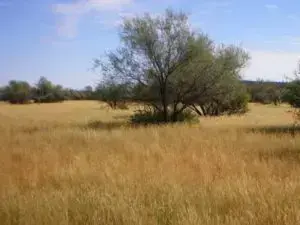
Thriving perennial pastures.
These cycles indicated to the family the importance of managing the balance between shrubs and pastures in maintaining the ecological function of the rangelands. From their work with animal nutrition, they came to realise that balancing shrubs and pastures in the rangelands was also important to cattle health and productivity.
Contemporary understanding of the rangeland ecology by government departments, natural resource management groups and even pastoralists such as the Forsyths has been that many of Australia’s semi-arid rangelands are shrub lands with little or no topsoil and little, if any, capacity to support perennial grasses. From their study however, the Forsyths concluded that diverse native perennial grasses had thrived in the rangelands in the past. They are now demonstrating that these grasses can thrive again, and showing that, with help, these pastures can also build soil, guard against erosion and increase ecological complexity and function.
Soil Management
INVESTING IN THE SOIL & CALMING THE WATERS
In regenerating the rangelands, Ben points out, “Our focus is on looking after the soils before other aspects of management, as this is where true sustainability will be judged”.
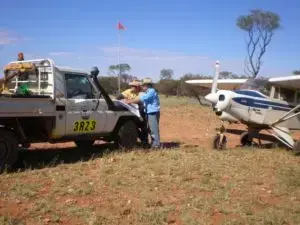
Ben and Graham use aerial photos to identify priority erosion locations for treatment.
The Forsyth priority for helping the soil recover its health is to firstly to slow down the flow of water on the landscape so that it soaks into the soil. The best tools for this job are diverse communities of vegetation – dense swards of perennial grasses, forbs, shrubs and some trees. The reduction in grazing pressure to very light grazing has already resulted in vegetation re-establishing in some of the better areas, such as where healthier, protected soils held seed banks of perennial grasses. Perennial grasses are particularly important because they are typically deep rooted and persist all year, so they hold and build soil. Because the rangelands have already lost a lot of soil and plant species over the last 100 years of pastoral management, it has become a race of regeneration against erosion.
Water Management
Graham and Ben judged that mechanical intervention was needed to speed up the recovery process and took advantage of earthworking equipment available through their contracting business. In the recovery process a fine balance is required between mechanical intervention, maximising perennial grass seed build up and the managed use of cattle.
Ben notes that they have been “Property planning using the EMU methods, identifying key erosion locations and required interventions and treatments on aerial photo overlays. These interventions have been implemented at a limited scale with encouraging results for controlling the loss of water from the landscape”.
The Forsyths have trialled and developed “water calming” interventions, starting at the erosion source areas and working downstream. The techniques used at Three Rivers include interventions such as bunds (raised embankments), rakes (evenly spaced poles embedded in the ground to catch debris) and strategic banks. (See images below.) These interventions are all slightly different methods for slowing water flow during rain events and spreading the water out over a large area so it becomes de-energised and loses its erosive power. Each has slightly different characteristics of performance and cost and is matched carefully to the situation being managed. As an added bonus, the interventions also trap debris and sediment which then becomes decomposing organic matter which in turn provides a nursery for grasses and shrubs to grow in.
An innovative approach to using local materials was generated by the Forsyth family’s intimate knowledge of their land. They had noticed that a locally available rock, calcrete*, had a binding action and was having a beneficial effect on regeneration of perennial grasses. The Forsyths had noticed that where the truck that carted the calcrete had bounced on rough ground and spilled calcrete, “The effect on the palatability of that grass was unbelievable. For the width of the truck, where the spillage was, grass had been chewed down to the ground to the edge of the spill, beyond that, the dry grass was totally left alone. There’s a lot more to it than meets the eye, that’s for sure. I don’t think much scientific work has been done on calcrete, I think we’re the first people to try anything”.
Where this rock had been used as a road surface, more grasses were growing along the road side. Whilst no soil testing has been performed, as the rock is highly alkaline, it appears that it was helping the soil chemistry to suit the perennials grasses as well as being a strong road surface. They put this insight into action where the remnant flood plains were actively eroding, using calcrete in their regenerative earthworks.
Bunds, rakes and banks are very practical in that they can be implemented with readily available equipment and they provide a rapid response as soon as it rains. They do not prevent flood water flow, but help to capture debris and sedimentation and to build soil and vegetation.

Left: Calcrete bund to slow and divert the flow of water. Right: Thriving kangaroo grass alongside the bund.
The areas of concern were mainly those lower in the landscape, the river bed and floodplains. Because of the soil characteristics of the area and the lack of topsoil, the remaining soil is vulnerable to slumping when it becomes wet. The resulting ‘crab holes’ become an issue if they start to join up, creating extensive fronts of sheetwash erosion. The Forsyths have seen this result in some significant incisions in the landscape.
A technique Graham and Ben have developed to address this is simple and effective. It consists of chamfering (flattening) the erosion face to give it a gradual slope rather than a vertical face, then lining the fresh face with calcrete. They have found that this is a very low risk approach, and even if the work fails in places, the calcrete armour prevents erosion from progressing. This technique appears to have an added bonus of the calcrete lifting the soil pH and helping the perennial grasses to grow vigorously.

Small ‘crab holes’ of collapsed soils (left) can spread to form massive fronts of sheet erosion (right).
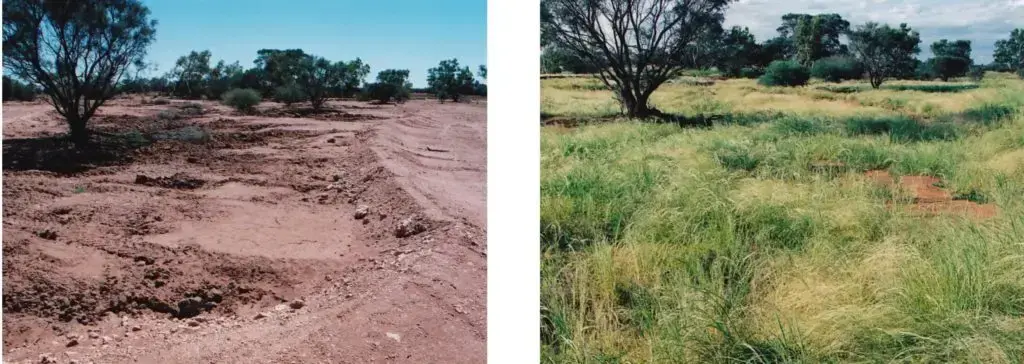
Chamfered erosion in September 2005 (left) and stabilisation through colonisation of annual and perennial grasses after summer rain (no flood) in March 2006 (right).
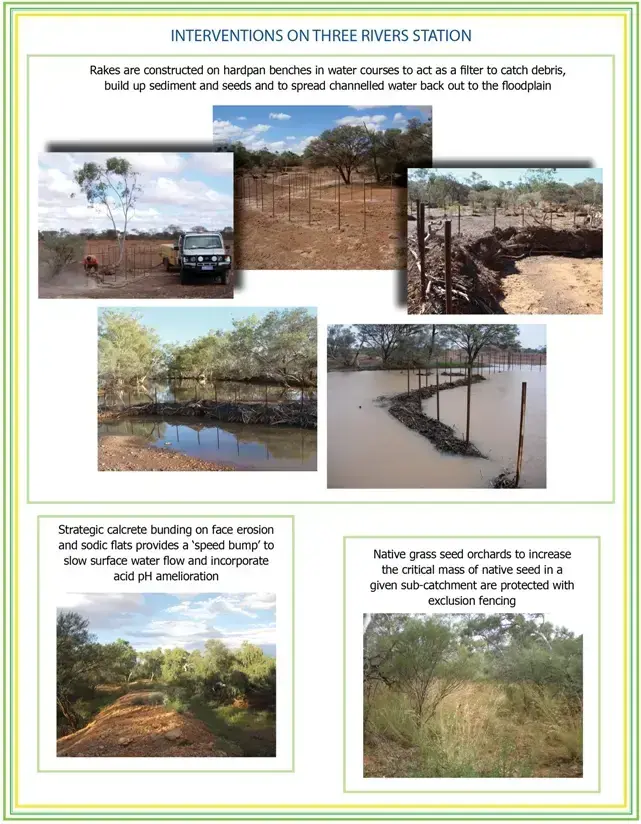
Vegetation Management
MOSAICS OF HEALING
…You change your intent towards your country and it responds.
The strategies put in place by the Forsyth family are clearly being successful in helping mosaics of regenerating soil and vegetation to establish and expand. Ben notes, “Historically Three Rivers has had a comprehensive photo and species count monitoring system in place. Due to the destocked period, and resultant drop in available time and money, monitoring has not been as thorough in recent years. Anecdotally, the perennial grass content of the pasture has dramatically increased in the last five years and there has been a definite decrease in erosion at the locations that have been treated”.
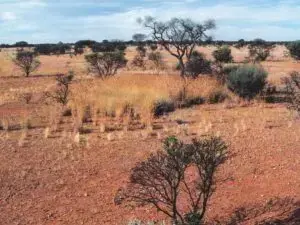
Recolonisation of perennial grasses after de-stocking, forming a seed bank.
Ben continues, “Significant increases in the population of perennial grass species has occurred since de-stocking happened in 2003-4. It is assumed that this will lead to an increase in soil biology and sequestration of carbon”. Perennial grasses such as kangaroo grass (Themeda triandra) and silky brown-top (Eulalia aurea) are recolonising areas in groves that formed after the destocking. On slightly-sloping sheetwash eroded terrain, alternating strips of sandy topsoil are supporting these groves, separated by usually bare gravel bands that only support low annual wind-grasses for a short time after rain. These clumps of grass form seed banks – or “seed orchards” – which allow the grasses to build and spread.
Kangaroos have long plagued Three Rivers Station, competing in droves for the scarce grasses with livestock. Ben and Graham have noticed that kangaroos prefer short grasses and will eat them to the roots, yet ignore longer grasses. Where grasses are growing taller, kangaroos are not to be found. As the impact of regeneration spreads across the landscape, Graham and Ben are seeing fewer and fewer kangaroos. They feel there is a strong possibility that, as the grassland returns, the kangaroos will maintain balanced and healthy numbers on Three Rivers Station.
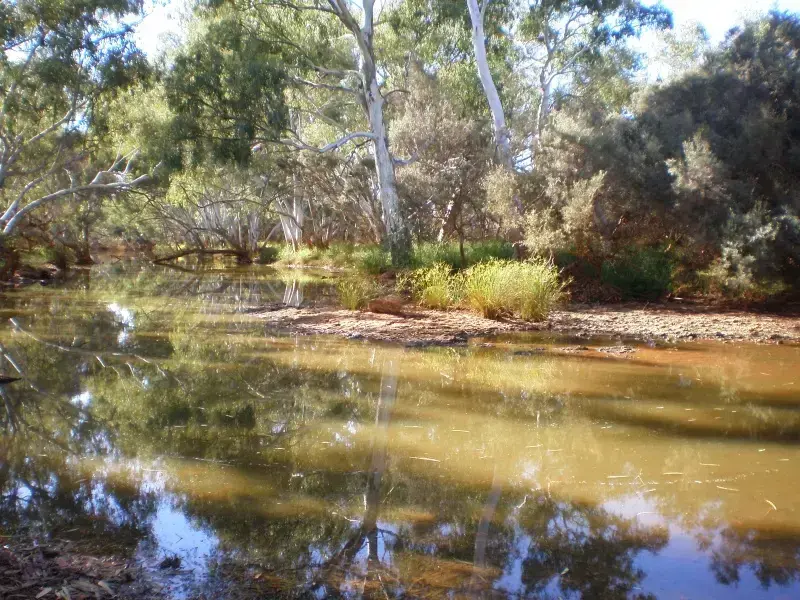
Water ponding upstream of established rakes.
Some gullies that were forming in the Middle Branch of the Gascoyne have been stabilised by the erosion-control earthworks and calcrete and this, combined with the respite from grazing from both cattle and kangaroos, has resulted in extensive perennial grass recruitment and probably increased recharge into groundwater. The river banks have more grass. Pools that used to exist upstream of the rakes have filled with sand. They still contain water, but as this is covered by 30cm or so of sand, there is no evaporation.
In one area, as is common, an accidental nick in the landscape due to road works on an old track had caused a small incision to start. This small incision had the capability of putting at risk the water course leaving some wetlands perched above the new stream level. The stream diversion banks, made of calcrete have been successful in stopping the progress of the incision and in restoring the flows of the river to this wetland.
Interestingly, a new grass has been found on Three Rivers which has not yet been identified. Graham Forsyth reports it as, “extremely vigorous, with very vigorous rhizomes and limited spread by seed. It produces a dense sward able to capture litter and sediment. It appears to be able to use soil moisture at any time and maintains green leaf well into dry periods. It is palatable to cattle and horses, both graze it only to a height of about 10cm.”

Left: Graham discussing the as-yet unidentified new grass on Three Rivers Station. Right: New grass shoot.
Graham says, “Nature’s wonderful and it’s just waited for the right circumstances and the manager of the land. You change your intent towards your country and it responds”.
Production
ON THE WAY TO RESTORATION
I believe we’re going to need every bit of productive country that earth’s got to offer over the next few years, we’ve got to nurture what we’ve got…
Graham and Ben are looking forward to being able to expand these early successes across the landscape to get the full effect of them. “From an individual and family perspective, it has been affirming to see the positive results from our dramatic and very costly action to de-stock back in 2003. This decision was made after we became aware of the accelerating soil erosion and landscape desiccation processes that were rampant. Our family has been greatly encouraged by the rapid increases in the regeneration of the perennial ground cover species and the obvious benefits of the earthworks that we have been able to construct to slow the water and spread it across flood plains.”
Once the mining activity in the area has been stabilised and the locations and requirements of the mines are known, pastoral operations will be able to be integrated back into the area. This is critical, not only the Forsyths, but to the ecological function of the area. Perennial grasses are an important component of the rangelands because of their function in protecting and building soil, storing carbon in the soil and infiltration of water into the subsoils and aquifers. Perennial grasses have evolved alongside grazing animals and the actions of grazing, trampling and recovery are vital to the renewal of the perennial plants and to the maintenance of plant diversity and abundance.
Graham and Ben have been studying leading grazing theory and practices from all over the world and integrated this knowledge with their own insights into the current and desired function of their land. Ben notes, “Destocking of the property allowed recovery while strategies were implemented”.
In April 2012, 400 cows were returned to Three Rivers Station and it is anticipated that grazing pressure will slowly be increased. Ben advises that they are, “Establishing a plan to introduce rest and rotation to the grazing strategy, rigorously maintaining total grazing pressure to remain within seasonal carrying capacity and embracing technology for water point management and livestock monitoring”.
The initial plan will see rotational grazing used across four paddocks on one floodplain area of Three Rivers Station. Once mining requirements become clearer and location of fence lines can be planned with confidence, Graham and Ben will sub-divide to smaller paddocks and a more intensive rotational grazing strategy. The strategy will be extended to other parts of the property as more grassland becomes available and resources become available to extend the watering and fencing infrastructure.

The locally appropriate plan for management of grazing aims to build the ecological function and sustainability of the pastoral enterprise, improve aquifer recharge and build soil carbon stocks, protect the rivers and drainages, produce ‘clean and green’ and healthy livestock in a financially satisfactory way. The Forsyths are investigating some new processes and technologies to lower the fossil fuel footprint of their operation. This includes use of recycled materials and new technologies such as virtual fencing.
Graham and Ben Forsyth believe that Australia’s rangelands are assets of national importance and responsibility for their condition extends beyond the current lease holders to the nation as a whole. Regenerated land at the headwaters of the Gascoyne and the Murchison will assist with the delivery of clean water downstream to important catchments surrounding Carnarvon. Fully regenerated pastoral leases will be vitally important to future generations through the revitalisation of the pastoral industry to help to meet the requirements for high quality protein for a growing population.
The Forsyth commitment to the land and its people shows in the determined and innovative approach they are taking to bringing the major stakeholders together to lead the process of taking collective responsibility for the degradation and working together to effect the regeneration and restore the decades of damage to the Gascoyne rangelands. Their leadership and innovation shows that together, mining companies, governments and farmers, as stewards of the land, have an opportunity for a strategic partnership in restoring the rangelands and realising the agricultural production opportunities that a healthy landscape will present.
As Graham concludes, “I believe we’re going to need every bit of productive country that earth’s got to offer over the next few years, we’ve got to nurture what we’ve got but if it can’t be bought into production viably, then you’ve got to find other ways to still bring it back. Because if we don’t bring it back, the Gascoyne River from this divide to the sea will just be a Grand Canyon. Now, we can’t let that happen”.
Outcomes
The locally appropriate plan for management of grazing aims to build the ecological function and sustainability of the pastoral enterprise, improve aquifer recharge and build soil carbon stocks, protect the rivers and drainages, produce ‘clean and green’ and healthy livestock in a financially satisfactory way. The Forsyths are investigating some new processes and technologies to lower the fossil fuel footprint of their operation. This includes use of recycled materials and new technologies such as virtual fencing.
Graham and Ben Forsyth believe that Australia’s rangelands are assets of national importance and responsibility for their condition extends beyond the current lease holders to the nation as a whole. Regenerated land at the headwaters of the Gascoyne and the Murchison will assist with the delivery of clean water downstream to important catchments surrounding Carnarvon. Fully regenerated pastoral leases will be vitally important to future generations through the revitalisation of the pastoral industry to help to meet the requirements for high quality protein for a growing population.
The Forsyth commitment to the land and its people shows in the determined and innovative approach they are taking to bringing the major stakeholders together to lead the process of taking collective responsibility for the degradation and working together to effect the regeneration and restore the decades of damage to the Gascoyne rangelands. Their leadership and innovation shows that together, mining companies, governments and farmers, as stewards of the land, have an opportunity for a strategic partnership in restoring the rangelands and realising the agricultural production opportunities that a healthy landscape will present.
As Graham concludes, “I believe we’re going to need every bit of productive country that earth’s got to offer over the next few years, we’ve got to nurture what we’ve got but if it can’t be bought into production viably, then you’ve got to find other ways to still bring it back. Because if we don’t bring it back, the Gascoyne River from this divide to the sea will just be a Grand Canyon. Now, we can’t let that happen”.



